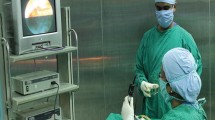Abstract
To evaluate the extent of posterosuperior bony overhang required to be removed for proper exposure of the incudo-stapedial complex during stapes surgery. Whether an assessment can be made out about the extent of the posterosuperior bony overhang clinically or not. A prospective study. One hundred patients of Stapedial Otosclerosis were included in this study. The direction of the posterosuperior bony canal wall i.e. straight or sloping type was recorded in every patient. All the patients underwent stapedotomy operation under local anaesthesia. The amount of overhang of the posterosuperior bony canal wall required to be removed for adequate exposure of the incudo-stapedial complex during stapes surgery was recorded by using measured right-angled picks of different sizes in mm. The aim of this study is to find out the extent of posterosuperior bony overhang and to know whether the posterosuperior bony overhang is more in straight or sloping bony canal wall. Fifty-seven percent of our patients had a medially sloping posterosuperior bony canal wall and 43% had a straight canal wall, which was noted clinically before surgery. The extent of posterosuperior bony overhang was divided into 4 groups: Gr. A ≤2 mm, Gr. B 2–2.5 mm, Gr. C 2.5–3 mm, Gr. D ≥3 mm. There were 25 patients in Group A, 55 in Group B, 20 in Group C and none in Group D. So majority (i.e. 55%) patients belonged to Group B i.e. 2–2.5 mm. The posterosuperior bony overhang is more in those patients who had straight bony canal than those who had sloping bony canal. This may be clinically assessed and this observation is statistically significant (P < 0.001).








Similar content being viewed by others
References
Smith M, Roberson J (1994) Otologic surgery. In: Brackman, Shelton, Arriaga (eds) Avoidance and management of complications, 1st edn. WB Saunders Co, Philadelphia, p 362
Miglets AW, Paparella MM (1986) Atlas of ear surgery, 4th edn. Saunders, Toronto, p 38
Glasscock ME, Shambaugh GE Jr (1990) Surgery of the ear, 2nd edn. Saunders, Philadelphia, p 393
Smyth GDL (1997) Scott Brown’s Otolaryngology, 6th edn., vol 3. Butterworth Heinemann, Oxford, p 3,14,15
Acknowledgments
We gratefully acknowledge Swami Sarvalokananda, Secretary, Ramakrishna Mission Seva Pratishthan, Vivekananda Institute of Medical Sciences and Prof. A. K. Saraf., Dean, Vivekananda Institute of Medical Sciences, for allowing us to use the hospital records during preparation of this article.
Author information
Authors and Affiliations
Corresponding author
Rights and permissions
About this article
Cite this article
Roychaudhuri, B.K., Roychowdhury, A., Ghosh, S. et al. Study on the Anatomical Variations of the Posterosuperior Bony Overhang of External Auditory Canal. Indian J Otolaryngol Head Neck Surg 63, 136–140 (2011). https://doi.org/10.1007/s12070-010-0101-x
Received:
Accepted:
Published:
Issue Date:
DOI: https://doi.org/10.1007/s12070-010-0101-x




